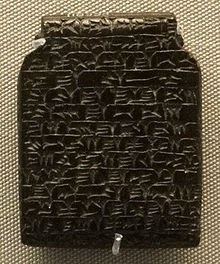Epic of the plague-god Erra
| Erra amulet | |
|---|---|

Amulet to ward off plague inscribed with a quotation from the Akkadian Erra Epic.
|
|
| Material | Stone, copper |
| Size | L:1.81 in (4.6 cm) W:1.25 in (3.2 cm) |
| Created | 800–612 BCE |
| Period/culture | Neo-Assyrian |
| Place | Ashur |
| Present location | Room 55, British Museum, London |
| Identification | 118998 |
Erra (sometimes called Irra) is an Akkadian plague god known from an 'epos' of the eighth century BCE. Erra is the god of mayhem and pestilence who is responsible for periods of political confusion. In the epic that is given the modern title Erra, the writer Kabti-ilani-Marduk, a descendant, he says, of Dabibi, presents himself in a colophon following the text as simply the transcriber of a visionary dream in which Erra himself revealed the text.
The poem opens with an invocation. The god Erra is sleeping fitfully with his consort (identified with Mamītum and not with the mother goddess Mami) but is roused by his advisor Išum and the Seven (Sibitti or Sebetti), who are the sons of heaven and earth—"champions without peer" is the repeated formula—and are each assigned a destructive destiny by Anu. Machinist and Sasson (1983) call them "personified weapons". The Sibitti call on Erra to lead the destruction of mankind. Išum tries to mollify Erra's wakened violence, to no avail. Foreign peoples invade Babylonia, but are struck down by plague. Even Marduk, the patron of Babylon, relinquishes his throne to Erra for a time. Tablets II and III are occupied with a debate between Erra and Išum. Erra goes to battle in Babylon, Sippar, Uruk, Dūr-Kurigalzu and Dēr. The world is turned upside down: righteous and unrighteous are killed alike. Erra orders Išum to complete the work by defeating Babylon's enemies. Then the god withdraws to his own seat in Emeslam with the terrifying Seven, and mankind is saved. A propitiatory prayer ends the work.
The poem must have been central to Babylonian culture: at least thirty-six copies have been recovered from five first-millennium sites—Assur, Babylon, Nineveh, Sultantepe and Ur—more, even, as the assyriologist and historian of religions Luigi Giovanni Cagni points out, than have been recovered of the Epic of Gilgamesh.
...
Wikipedia
